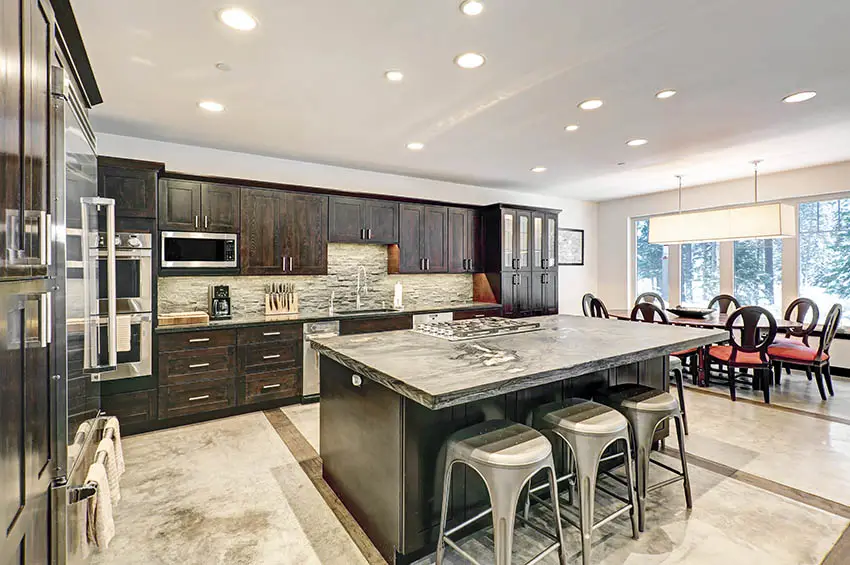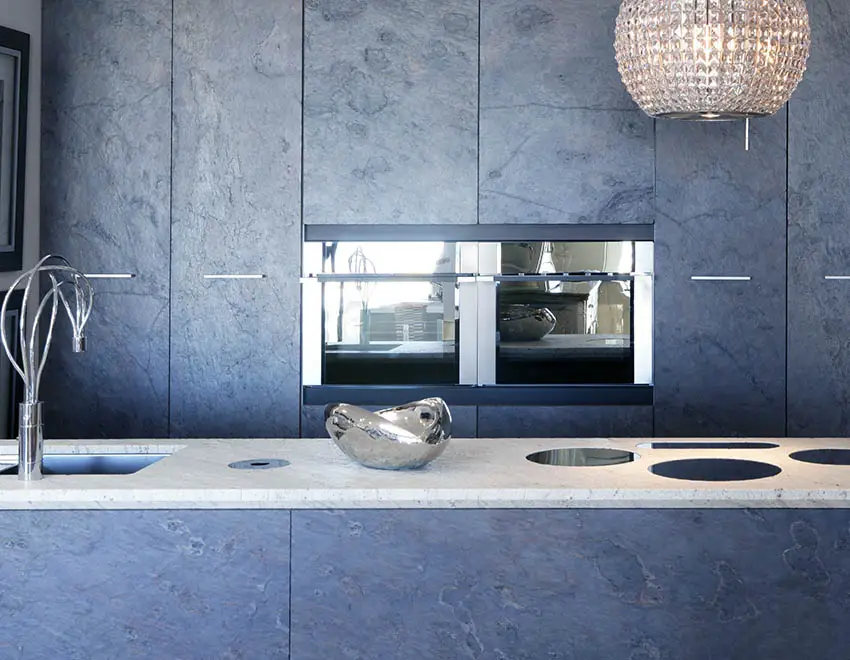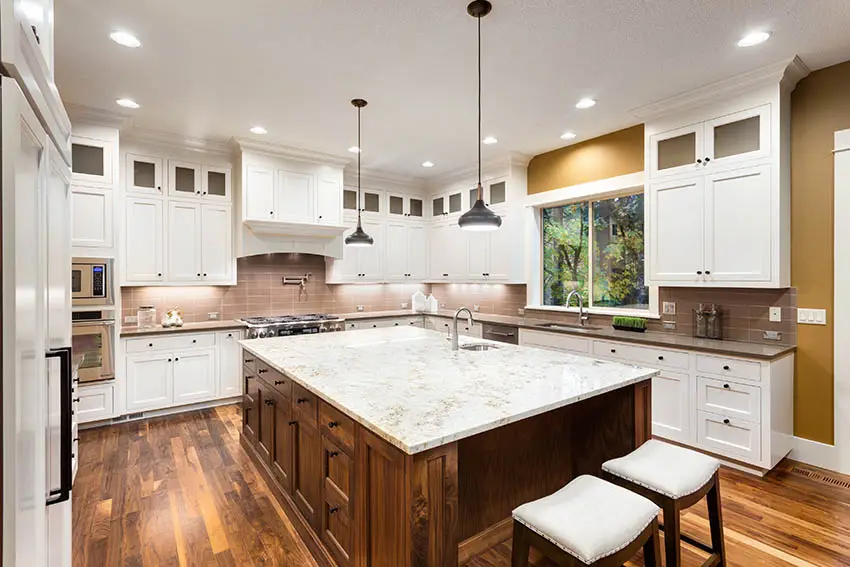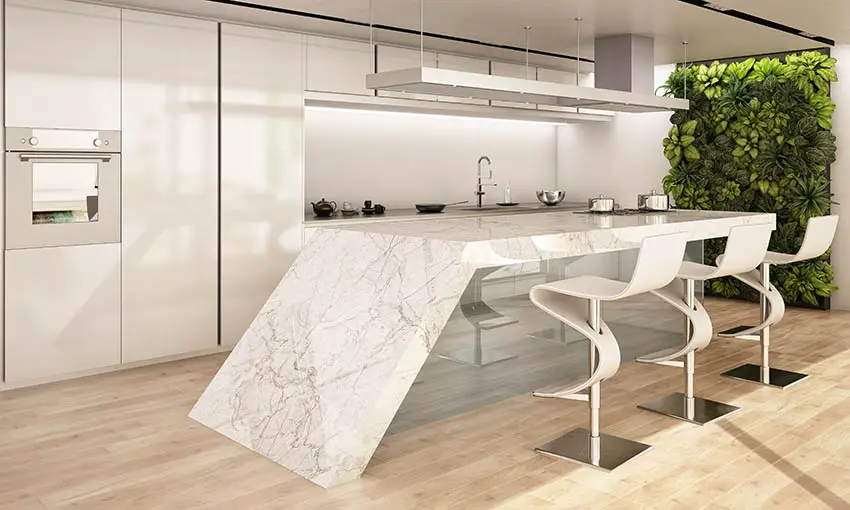Here we discuss what Is sintered stone including its cost and differences vs granite and quartz.
 Sintered stone is one of the new hot topics in the interior design world. This is because they are the best of both worlds – natural and engineered.
Sintered stone is one of the new hot topics in the interior design world. This is because they are the best of both worlds – natural and engineered.
Sintered stone uses natural materials that make for beautiful surfaces, and it uses an engineered process that adds speed and flexibility. The speed helps save money, and the flexibility allows the choice of color, texture and size.
All these options are available, while still having the quality materials at the base of the surface.
Table of Contents
What Is Sintering?
Sintering is a process of combining multiple materials into one solid piece. The process actually mimics that of the natural process that creates granite.
Basically the sintering process is the manmade version of the intense heat and pressure that the earth does to materials to create certain surfaces.
When making a sintered stone surface, the materials themselves must be selected and then follow this process, mimicking that of the earth.
To choose which natural materials are put together it is best to know what colors and textures are desired in the final outcome.
Typically in interior design something that has been sintered is made to be used as an expensive kitchen countertop, there are many other uses for this material such as fireplace surfaces, wall cladding and flooring.
What Are Sintered Surfaces?
 Sintered surfaces are made from natural materials that go through the engineered process of sintering, which mimics the natural compression and heat of the environment.
Sintered surfaces are made from natural materials that go through the engineered process of sintering, which mimics the natural compression and heat of the environment.
Sintered surfaces give the illusion of natural faults and unique qualities. Sintered stone can appear like natural stone, wood, or even a smooth surface.
This type of stone can be made into a variety of colors, shapes, sizes and textures, all while still using natural materials. This stone is a relatively light material, requiring less structural elements in the surface.
Sintered stone is a common choice when it comes to countertops as well as backsplashes and other kitchen finishes. It can also be used for flooring, swimming pools, outdoors flooring, pools and spas.
These stone surfaces can be used to cover large areas as it is durable, easily cleaned and has a good price point. Sintered stone is extremely applicable in outdoor settings as it is both waterproof and weatherproof.
How Much Does Sintered Stone Cost?
Sintered stone is typically measured and priced by square footage. The price per square foot on sintered stone is around $60 to $100 installed.
This can vary based on design, colors, shapes and sizes. Depending on the area, installer and installation materials needed the price can change a little bit as well.
The price will decrease if you can do the installation yourself. Do it yourself installation is not the recommended method though, it typically requires a professional.
On average, the total price comes to about $3750 all said and done. For higher end or larger pieces, you can expect a price of about $5000, and for lower end or smaller pieces they can run as low as $1000. Get a quote from your local dealer for and exact price.
Sintered Stone vs Granite
 Sintered stone is a manufactured piece of stone, while granite is a natural material.
Sintered stone is a manufactured piece of stone, while granite is a natural material.
Granite is a very durable material to avoid cracking and breaking, as well as heat resistant. Granite is also tough enough to dull knives! Unfortunately since granite is a natural material it is quite porous and must be sealed every 6 months.
This type of stone has a ton of great qualities that compare to the ever sought after granite countertops.
Similar to the granite mentioned above, sintered stone is resistant to heat, as well as ice and freezing temperatures. It is also resistant to scratches and IV rays that can cause imperfections in the surface.
While granite is a porous material, sintered stone is the opposite, instead being a waterproof material without needing to be sealed.
Thanks to the resistance to scratching and the waterproof quality, it is way more hygienic than a surface like granite that could harbor bacteria if not taken care of properly.
Additionally, sintered stone has a broad selections of colors, pigmentation and designs available, while granite is typically based on the natural elements creating it.
Granite is an extremely heavy material and can be quite difficult to install yourself, this is generally the same when it comes to this type of stone, but it is lighter, depending on the size.
Additionally the sintered stone has a high mechanical resistance, meaning that it has flexural structure. Flexural structure relates to how much support the surface needs and how thin it can be. Sintered stone can be thinner and require less supports than the granite counters would need.
Sintered Stone vs Quartz
 Sintered stone and quartz share the quality of being a man-made engineered stone.
Sintered stone and quartz share the quality of being a man-made engineered stone.
Quartz is a non porous stone as well as has resistance to both staining and scratching. The biggest difference of the sintered stone and the quartz stones, is that sintered stone is made from natural materials, while quartz includes man-made products like resin and binders.
Both of these stones are made by engineered processes so that they can have quicker turnarounds. One downside of quartz is that if it is exposed to extreme heat, it has the possibility of getting burnt, while sintered stone can withstand the high temperatures.
Both sintered stone and quartz are extremely hard, even harder than granite, sintered being slightly harder than quartz. As mentioned, quartz is non porous, as is the sintered stone meaning they are extremely hygienic and antimicrobial.
Additionally, both of these materials are able to be selected and made in a variety of different colors. This is because the color can change during the manufacturing process.
Sintered stone is particularly useful in long applications and islands. It is a lighter surface, compared to other natural materials.
This is important because it can allow the user to have a longer overhang as well. Not only can they have a longer overhang, but they also can have less supports as there is a lesser possibility of it breaking.
https://www.gm-stone.com/product-category/sintered-garden-patio-pavers/
https://www.gm-stone.com/product-category/sintered-quartz-slab/
https://www.gm-stone.com/product-category/ecological-stone/
